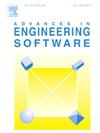An optimization strategy for customizable global elastic deformation of unit cell-based metamaterials with variable material section discretization
IF 4
2区 工程技术
Q2 COMPUTER SCIENCE, INTERDISCIPLINARY APPLICATIONS
引用次数: 0
Abstract
Metamaterials with their distinctive unit cell-based periodic architecture feature a wide range of possible properties with unusual characteristics and a high potential for optimization. Due to their complex interaction between unit cell geometry and material properties, as well as their inherent multi-scale nature, suitable optimization strategies need to be developed for metamaterials. One potential approach is to optimize the distribution of unit cells within a part to achieve a predefined deformation response. However, a significant challenge lies in determining the appropriate number and distribution of areas with varying properties (material sections) to facilitate an efficient optimization. In this study, a variable material section discretization scheme is presented, which is aimed at automatically updating the discretization to enhance the efficiency of metamaterial optimizations. This scheme is implemented as an extension to a previously proposed Finite Element simulation-based optimization framework for unit cell-based metamaterials. The framework includes a numerical homogenization method and interpolation scheme for efficiently correlating unit cell parameters with homogenized material properties, coupled with a black-box optimization method. In the present study, the previously proposed framework was extended to incorporate a scheme for monitoring and adjusting the material section discretization during the optimization process. To assess the effectiveness of the implemented routine, it was tested in conjunction with a genetic algorithm for optimizing the parameter distribution of a 2D tri-anti-chiral metamaterial to match a predefined lateral deformation under load.
采用可变材料截面离散度的基于单元格的超材料全局弹性变形定制优化策略
超材料具有独特的基于单元格的周期性结构,具有广泛的可能特性,具有不同寻常的特点和巨大的优化潜力。由于单元格几何形状与材料特性之间的复杂互动关系,以及其固有的多尺度特性,需要为超材料开发合适的优化策略。一种可能的方法是优化单元格在部件中的分布,以实现预定义的变形响应。然而,如何确定具有不同特性的区域(材料部分)的适当数量和分布,以促进高效优化,是一项重大挑战。本研究提出了一种可变材料截面离散化方案,旨在自动更新离散化,提高超材料优化的效率。该方案是对之前提出的基于有限元模拟的优化框架的扩展,适用于基于单元的超材料。该框架包括一种数值均质化方法和插值方案,用于有效地将单元格参数与均质化材料特性相关联,并与黑盒优化方法相结合。在本研究中,对之前提出的框架进行了扩展,纳入了在优化过程中监测和调整材料截面离散化的方案。为了评估实施例程的有效性,我们结合遗传算法对其进行了测试,以优化二维三反手性超材料的参数分布,使其与负载下的预定侧向变形相匹配。
本文章由计算机程序翻译,如有差异,请以英文原文为准。
求助全文
约1分钟内获得全文
求助全文
来源期刊

Advances in Engineering Software
工程技术-计算机:跨学科应用
CiteScore
7.70
自引率
4.20%
发文量
169
审稿时长
37 days
期刊介绍:
The objective of this journal is to communicate recent and projected advances in computer-based engineering techniques. The fields covered include mechanical, aerospace, civil and environmental engineering, with an emphasis on research and development leading to practical problem-solving.
The scope of the journal includes:
• Innovative computational strategies and numerical algorithms for large-scale engineering problems
• Analysis and simulation techniques and systems
• Model and mesh generation
• Control of the accuracy, stability and efficiency of computational process
• Exploitation of new computing environments (eg distributed hetergeneous and collaborative computing)
• Advanced visualization techniques, virtual environments and prototyping
• Applications of AI, knowledge-based systems, computational intelligence, including fuzzy logic, neural networks and evolutionary computations
• Application of object-oriented technology to engineering problems
• Intelligent human computer interfaces
• Design automation, multidisciplinary design and optimization
• CAD, CAE and integrated process and product development systems
• Quality and reliability.
 求助内容:
求助内容: 应助结果提醒方式:
应助结果提醒方式:


